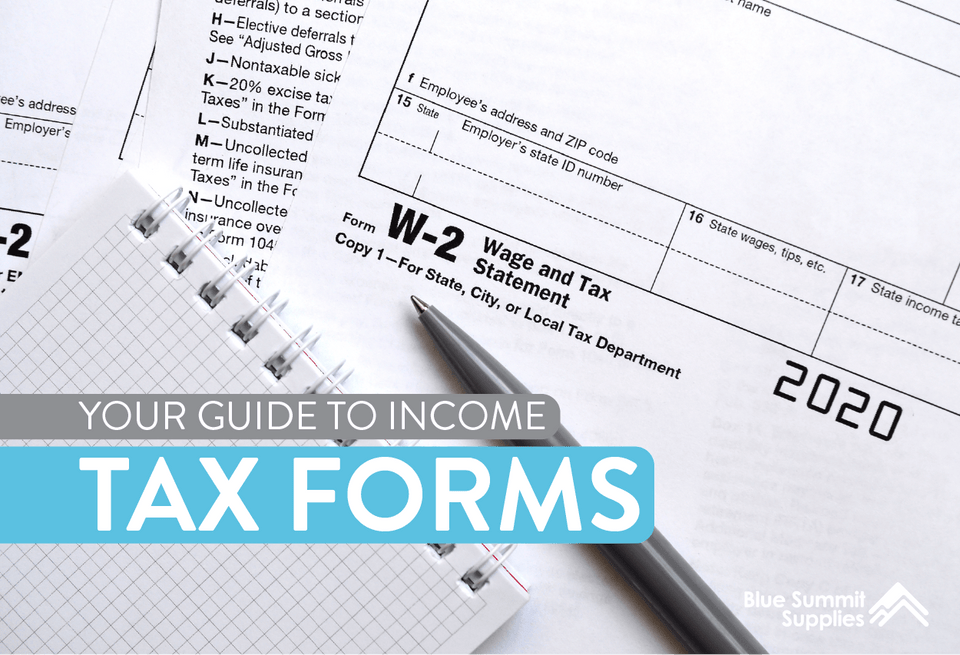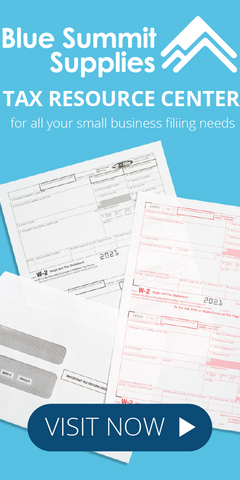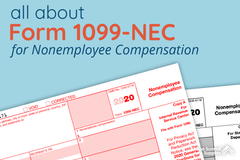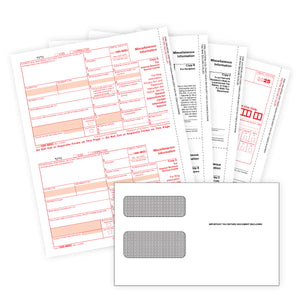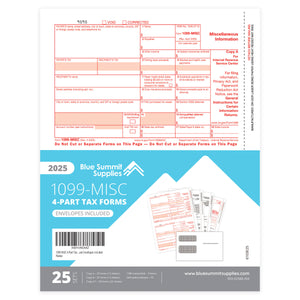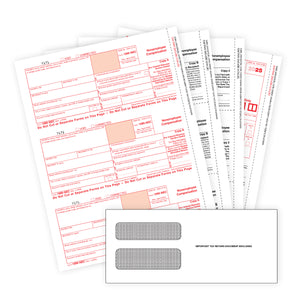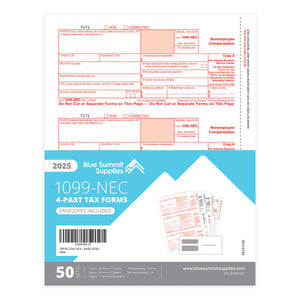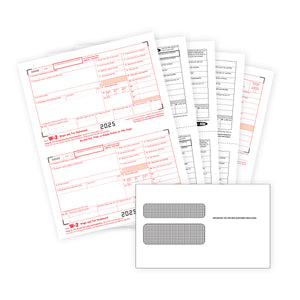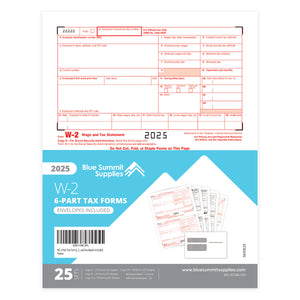Tax season is upon us and ideally, you’re already prepared. You may be prepared without even realizing it – most businesses are in the habit of saving financial records and receipts throughout the year. Make sure you have a scalable filing system to keep your financial documents in order and at your fingertips. But even with all the organization in the world, you may still need a guide to the different forms of income tax return. We’ve got you covered.
In order to file taxes as an employer or an employee, you’ll need the appropriate tax forms. We know firsthand how confusing tax forms can be, so we’ve put together this quick primer to simplify your tax season.
If any of this is confusing as either an employer or an employee, consider hiring a Certified Public Accountant. At Blue Summit Supplies we know tax forms, but we aren’t certified public accountants, and none were consulted to write this article. A good CPA is worth his or her weight in gold. Connect with a seasoned CPA or small business tax accountant who will answer your questions year-round and make sure your investment into financial help is worthwhile. We’ve provided some tips to finding a quality CPA toward the end of the piece.
What do I need to know as an employer?
As an employer, you’re responsible for providing your employees with the appropriate tax forms. It’s up to you to populate these forms with the relevant taxable earnings. The best way to do this is using a bookkeeping software like QuickBooks to print directly onto IRS-standard tax forms. There are also small business bookkeeping course options if you are new to handling taxes.
Small Business Bookkeeping Courses
If you pursue the small business bookkeeping course option, make sure the course is accredited or highly reviewed. Here are some of our favorite small business bookkeeping courses.
- National Bookkeeping Association’s Bookkeeping for Small Business Course, $159 with membership*
- TeachUComp, Inc’s Introduction to Small Business Accounting Training Tutorial, hosted on Udemy, $24.99*
- Penn Foster Career School’s Bookkeeping Course, $49 monthly*
- US Career Institute’s Online Bookkeeping School, starting at $589*
- Colorado Technical University’s online Associates Degree in Accounting, $325 per credit hour*
*at the time of publication.
What do I need to know as an employee?
As an employee, it’s your employer’s job to provide you with the appropriate tax forms. When you began working, you should have filled out forms for income taxation purposes. You will use this information to complete the 1040 form to be submitted to the IRS. This is how you will find out if you owe more taxes or are due a refund.
All About W2s
A W-2 form is the most commonly used tax document. It reports all federal, state, and other taxes withheld from an employee’s paycheck.

For employers
Your involvement with the W-2 form will be denser than your employee’s, since you are required to prepare and provide several copies of each W-2 per employee. It’s a lot of paper and the cost can add up quickly, so make sure you shop around for the best deal. When you order W-2 forms, they should come with a W-3 form. This is the transmittal form you, the employer, are solely responsible for.
What is a Transmittal?
A transmittal form is sent from an employer to the government (the Social Security Administration) documenting the financial information relating to an employee, a contractor, a vendor, or other entity you have paid for a service since your last tax window. This is a way for the government to know what the employee was paid and ensure the information lines up with what the employee claims they made.
The most common transmittal tax forms are W-3 forms and 1096 forms, which summarize all the company’s W-2 forms and 1099 forms respectively.
How many parts should my W-2s have?
It is up to you to determine how many parts your form W-2 should have. The IRS resource center, USTaxCenter, tells us there are 6 parts to an official W-2: copies A, B, C, D, 1, and 2.
- Copy A - Submitted by the employer to the Social Security Administration. (In addition, the employer must also submit Form W-3, which is a summary of all Forms W-2 completed, along with all Copies A submitted. The Form W-3 must be signed by the employer.)
- Copy B - To be sent to the employee and filed by the employee with the employee's federal income tax returns.
- Copy C - To be sent to the employee, to be retained by the employee for the employee's records.
- Copy D - To be retained by the employer, for the employer's records.
- Copy 1 - To be filed with the employer's state or local income tax returns (if any).
- Copy 2 - To be filed with the employee's state or local income tax returns (if any).
Depending on your location, you could need a 4-part, 6-part, or 8-part W-2.
You can check with a local tax expert to determine which you’ll need, or go by this unofficial guide:
- If you don’t have to pay state income tax, choose the 4-part W-2 tax form.
- If you do have to pay state income tax, choose the 6-part W-2 tax form.
- If you need more than 6 parts, don’t distress if you can’t find a tax form with more than six parts. Just be sure to purchase enough of the relevant parts to cover your needs.
For employees
According to Forbes, “A form W-2 is issued by an employer to an employee. The threshold for issuing a form W-2 is based on dollars – nothing else matters. Not time worked. Not position held. Just dollars (or dollar equivalents) earned. The magic number is $600.”
This means if you’ve worked for a company as a W-2 employee and earned at least $600, you should receive a W-2 form from your employer.
Information on your W-2 is vital to preparing your tax return. Your employer is legally obligated to send you your W-2 by January 31st at the latest, which leaves you several weeks to file your taxes. You are legally obligated to report all wages you earned from your job (or jobs) over the past year.
The W-2 is formally referred to as the ‘Wage and Tax Statement’ and details are extremely important. Make sure you have your correct address on file with your employer. If your W2 is sent to the wrong address, it can make filing your taxes take even longer. Don’t risk the wait – if you haven’t received your W-2 by February 15th, ask your employer for a new copy and ensure it’s headed to the right address. If this still doesn’t get your W-2 into your hands, give the IRS a call at 1-800-829-1040 to rectify it. Make sure to have key information on hand, like when you worked and roughly how much you were paid.
Filling out your W-2
How to fill out your W-2 varies depending on several factors like location and exemptions. The IRS provides a comprehensive guide to filling out W-2s. (It’s dense but full of useful information straight from the source!)
Most information on your tax forms should be pre-populated by your employer. The empty boxes are clearly labeled but can get confusing. Seek help from an accredited CPA or consider using a tax software to save time and headache.
Choosing the Best Tax Software
According to Eva Rosenberg, founder of TaxMama.com, you should limit your tax software options “to [the following] companies that work with the Free File Alliance. These companies have been approved by the IRS and meet security and privacy standards.”
- H&R Block
- Intuit
- Liberty Tax
- Drake Enterprises
- EzTaxReturn.com
- FileYourTaxes.com
- Free Tax Returns
- OnLine Taxes
- TaxAct
- TaxHawk
- TaxSlayer
All About 1099s
We’ve learned W-2s are for employees, so what are 1099s?
A 1099 form is for independent contractors. It records income made as a freelancer, contractor, or other source of work that isn’t a W-2 position. Unlike receiving a single W-2 from one employer, if you’re a freelancer you will likely receive several 1099 forms, one (or more) from each of your clients.

For employers
It is your responsibility to send out individual 1099s to each of your contractors. You must also send 1096s to the government. A 1096 form is a transmittal form, just like a W-3. It is the companion form to the 1096. The organization paying the contractor is responsible for sending a 1096 to the IRS detailing wages paid to the contractor, so the government knows how much the contractor should be taxed.
For employees
Just like a W-2, the magic number is $600. If you were paid $600 or more by a business or individual, you are obligated to file a 1099 and pay taxes to the IRS.
I didn’t get a 1099 – what do I do?
Even if your client didn’t provide you a 1099 form, you’re still responsible for paying your taxes. Failure to do so could have expensive consequences. Report your miscellaneous income on a Form 1040 Schedule C, Profit and Loss for Business. It is a good rule of thumb to keep all pay stubs or proofs of payment on hand throughout the year, so you can more easily report your earnings when it’s time to pay taxes.
How are 1099s different than W-2s?
Unlike a W-2 form, a 1099 doesn’t show the taxes an employee has already paid the government. Instead it shows the total income a contractor has made from each client, and it’s up to the contractor to calculate owed taxes and pay this amount on their own. Where W-2 employees have their taxes withheld, 1099 contractors are paid their full amount and expected to pay their taxes individually.
An important note: If you expect to owe $1000 or more annually in taxes, you may be required to pay quarterly taxes the next year. Check this QuickBooks resource to see if this applies to you to ensure you avoid paying extra in penalties and fees.
What is Form 1099-NEC?

Starting in the 2020 tax year, Form 1099-NEC replaces Form 1099-MISC for reporting nonemployee compensation. Businesses will need to file Form 1099-NEC in the 2021 tax season to report nonemployee compensation paid during the 2020 tax year.
What other tax forms should I know?
There are many other tax forms out there, but below are a few key forms you might encounter.
The W-9 Form
According to the IRS, the W-9 is “used to request a taxpayer identification number (TIN) and certification.” It’s a form for contractors that provides their employer with their taxpayer identification number. The W-9 doesn’t go to the IRS and is used for internal accounting purposes.
The W-4 Form
The W-4 is the form you use to tell your employer how much money to withhold from each paycheck for federal taxes. Employees fill this out at the start of employment. Filling out your W-4 accurately ensures you won’t owe the IRS a big balance come tax season or overpay throughout the year.
The 1040 Schedule C Form
As mentioned above, the 1040 Schedule C form is a way for you to track your miscellaneous expenses and ensure you’re paying the correct taxes. It’s for self-employed individuals or contractors individually managing their businesses. The IRS defines activities as business if “your primary purpose for engaging in the activity is for income or profit, and you are involved in the activity with continuity and regularity.”
As an employer, when do I send forms to my employees or contractors?
The deadline for mailing tax forms to your employees is January 31st of each tax year. Between January 1st and January 31st is the window for sending your employees their W-2s.
As an employee, when do I file my taxes?
The deadline for filing your taxes is Thursday, April 15.
As a contractor OR an employee, should I save my paystubs?
Yes. It’s always best practice to save paystubs, at least sporadically, and file them by date. The IRS and the state in which you file taxes can both ask for copies of paystubs if there are errors or mismatches in the system, or if your employer didn’t file properly (or at all). Be safe rather than sorry by keeping proof of your wages just in case any questions should arise regarding your financial claims.
Where do I file my taxes?
You can file your tax forms online using a software like those suggested above, or you can mail in hard copies of your forms. The IRS blog USTaxCenter says, “Those who are filing a paper tax return will need to mail it to the IRS upon completion. On the other hand, if you are using tax preparation software or filing through a tax professional, electronic filing may be a better option. Tax returns that are submitted electronically are often processed faster, which means a faster tax refund for the taxpayer.”
How can I find and hire a quality accountant?
While it’s possible to file your taxes yourself, hiring an accountant can be a worthwhile way to get peace of mind. Paying the expense to have your taxes professional prepared or filed by a trusted pro can save you headaches and time in the long run.
Entrepreneur.com suggests “the best way to find a good accountant is to get a referral from your attorney, your banker, or a business colleague. You can also check in with the Society of Certified Public Accountants in your state, which can make a referral.”
Remember to hire a Certified Public Accountant, since the certification means the accountant has passed a “rigorous, two-day, nationally standardized test” and “most states require a CPA to have at least a college degree or its equivalent.” If you’re going to invest the money, make sure to invest in the best.
What else do I need to know?
If you still have questions or need to know more about specific forms, visit the IRS website. It’s an excellent resource for learning all things taxes, including tax forms.
This article is designed to provide accurate and authoritative information. However, it is not a substitute for legal advice and does not provide legal opinions on any specific facts or services. The information is provided with the understanding that any person or entity involved in creating, producing or distributing this article is not liable for any damages arising out of the use or inability to use this product. You are urged to consult an attorney concerning your particular situation and any specific questions or concerns you may have.
 For more informative articles about office supplies, subscribe to our email newsletter!
For more informative articles about office supplies, subscribe to our email newsletter!
Never fear, you won't begin receiving daily sales emails that belong in a spam folder. Instead, we promise a fun weekly roundup of our latest blog posts and great finds from across the web. And if you lose interest, it's always easy to unsubscribe with a single click.

